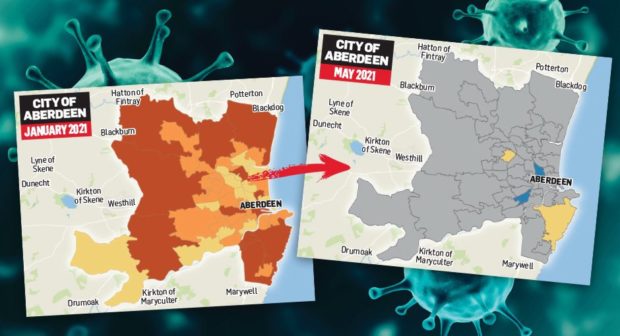Covid cases in the north-east are down more than 95% compared to the start of the year.
In the first seven days of 2021, 1,397 cases were detected in Aberdeen and Aberdeenshire.
In the last seven days, between April 25 and May 1, the number of cases in the region is just 62.
The seven-day positive rate per 100,000 for the region remains at the lowest level since mid-September.
On September 19, Aberdeen’s rate was 18.37. The latest figure shows the city’s rate is now 15.7.
At the start of the year around 12% of all people tested showed a positive result for Covid-19. Now only 0.6% of tests are positive.
How is the positivity rate calculated?
Coronavirus cases can be put into context by looking at them as a rate per 100,000 population.
This rate is then categorised into one of five bands by Public Health Scotland (PHS). If the number of cases in the seven-day period is two or fewer, it is marked as suppressed.
Each area of the country has been divided into regions of roughly similar populations, and are the same used in a wide range of national datasets released by the Scottish Government.
In the past day, there have been no new deaths registered, this means the total since the beginning of the pandemic remains at 7,660.
In the past 24 hours, 139 new cases were reported, with around 1.1% of those people tested returning positive results.
A total of 226,644 people have now tested positive in Scotland.
What’s the picture like Scotland wide?
The Scotland-wide seven-day positive rate per 100,000 population is 21.3, with 1,165 people testing positive during this period – down around 300 on the previous week.
Of all the tests carried out, 1.1% returned a positive result.
Moray has the highest rate per 100,000 in Scotland at 78.3. Seventy-five new cases were discovered in the region in the last seven days.
Aberdeen
In the first week of January, 666 cases were recorded in Aberdeen. Since then 2,453 people in the city have tested positive for the virus according to Public Health Scotland.
In the latest seven-day figures, just 33 people tested positive for the virus.
Aberdeen now has an average rate per 100,000 population of 14.4, down from 291.2 at the beginning of the year.
At the beginning of the year, every area of the city had a rate of more than 100 cases per 100,000, with the majority of areas above 200, with around a third of Aberdeen having more than 400 cases per 100,000 people.
Now, only four areas of the city have any data reported. The areas marked grey on the above map have between 0 and two cases.
George Street has the highest number of cases in Aberdeen, with seven confirmed in the last week.
Cummings Park in the north of the city recorded five confirmed cases.
Councillor for Northfield and Mastrick North Jackie Dunbar, said: “It’s fantastic that measures put in place are having a positive effect and it’s all down to the effort of folk who have been following the rules and observing FACTS.”
“I’d like to thank everyone for going their part and I hope it continues for the foreseeable future.”
Aberdeenshire
In Aberdeenshire, there have been 29 cases in the last seven-day period, with a positive rate of 8.81 per 100,000 – below that of the Scottish average.
Comparing this to the first week of January, where the number of cases detected was 731, shows the progress that has been made.
Since January 7 a total of 2,228 people have tested positive for the virus in Aberdeenshire.
The test positivity rate for the region is now at just 0.5%, significantly lower than the 12.4% reported between January 1 and 7.
In the first week of 2021, all but five neighbourhoods in Aberdeenshire had cases below 100 per 100,000.
Now just four areas have their figures made public by PHS.
This includes Longside and Rattray with seven cases and a rate of 50 to 99. Aboyne and South Deeside, Crathes and Torphins and Balmedie and Potterton also have a rate of between 50 and 99.
Councillor Anne Allan for Peterhead North and Rattray said: “I’m delighted to hear that the rate of infection is continuing to decrease across the shire, despite the fact that there are some small pockets where cases are slightly higher.
“But we must continue to adhere to the guidelines and we are not out of the woods yet.
“The virus hasn’t gone and it will come back wherever it has the opportunity to, so we must continue to follow the guidance when it comes to meeting up safely.”
